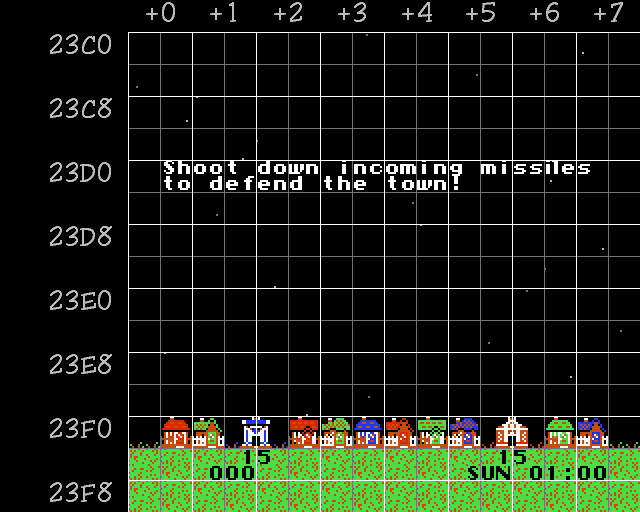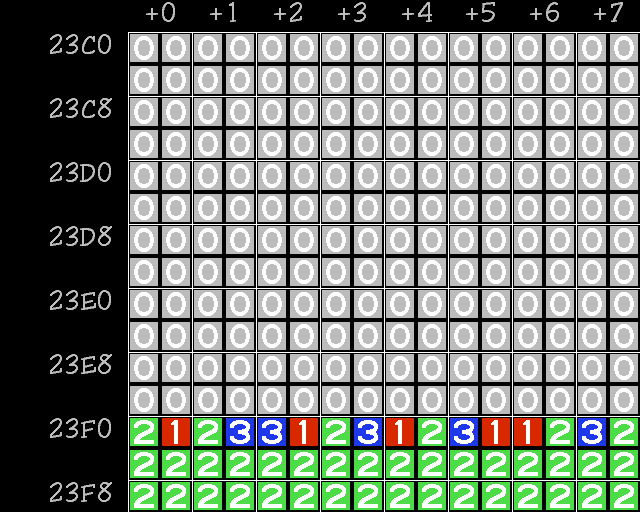PPU attribute tables: Difference between revisions
Hamtaro126 (talk | contribs) m (→Glitches: There was a typo on the attempt to add an Multiplication sign.) |
m ("it's" and "its" mean completely different things) |
||
| Line 81: | Line 81: | ||
There are some well known glitches when rendering attributes in NES and Famicom games. | There are some well known glitches when rendering attributes in NES and Famicom games. | ||
The Attribute Table in each of the four Name Table (and | The Attribute Table in each of the four Name Table (and its mirrors), contains four colors, and four 16x16 segments out of a 32x32 segment, (as in: 2 bits x 4 = 1 Byte,) | ||
This is the reason why games that use the Horizontal or Vertical [[Mirroring]] mode for Diagonal [[PPU scrolling|Scrolling]] often have color artifacts on one side of the screen (on the right side in ''Super Mario Bros. 3''; on the trailing side of the scroll in ''Kirby's Adventure''; and at the top and bottom in ''Super C''). | This is the reason why games that use the Horizontal or Vertical [[Mirroring]] mode for Diagonal [[PPU scrolling|Scrolling]] often have color artifacts on one side of the screen (on the right side in ''Super Mario Bros. 3''; on the trailing side of the scroll in ''Kirby's Adventure''; and at the top and bottom in ''Super C''). | ||
The game ''Alfred Chicken'' hides them completely by using left clipping and hiding the right side of the screen with solid-colored sprites. Such approach would occupy 15 entries of 64 in the sprite table in 8x16 sprite mode, or 30 entries in the 8x8 mode. | The game ''Alfred Chicken'' hides them completely by using left clipping and hiding the right side of the screen with solid-colored sprites. Such approach would occupy 15 entries of 64 in the sprite table in 8x16 sprite mode, or 30 entries in the 8x8 mode. | ||
Revision as of 17:21, 11 June 2017
The attribute table is a 64-byte array at the end of each nametable that controls which palette is assigned to each part of the background.
Each attribute table, starting at $23C0, $27C0, $2BC0, or $2FC0, is arranged as an 8x8 byte array:
2xx0 2xx1 2xx2 2xx3 2xx4 2xx5 2xx6 2xx7
,-------+-------+-------+-------+-------+-------+-------+-------.
| . | . | . | . | . | . | . | . |
2xC0:| - + - | - + - | - + - | - + - | - + - | - + - | - + - | - + - |
| . | . | . | . | . | . | . | . |
+-------+-------+-------+-------+-------+-------+-------+-------+
| . | . | . | . | . | . | . | . |
2xC8:| - + - | - + - | - + - | - + - | - + - | - + - | - + - | - + - |
| . | . | . | . | . | . | . | . |
+-------+-------+-------+-------+-------+-------+-------+-------+
| . | . | . | . | . | . | . | . |
2xD0:| - + - | - + - | - + - | - + - | - + - | - + - | - + - | - + - |
| . | . | . | . | . | . | . | . |
+-------+-------+-------+-------+-------+-------+-------+-------+
| . | . | . | . | . | . | . | . |
2xD8:| - + - | - + - | - + - | - + - | - + - | - + - | - + - | - + - |
| . | . | . | . | . | . | . | . |
+-------+-------+-------+-------+-------+-------+-------+-------+
| . | . | . | . | . | . | . | . |
2xE0:| - + - | - + - | - + - | - + - | - + - | - + - | - + - | - + - |
| . | . | . | . | . | . | . | . |
+-------+-------+-------+-------+-------+-------+-------+-------+
| . | . | . | . | . | . | . | . |
2xE8:| - + - | - + - | - + - | - + - | - + - | - + - | - + - | - + - |
| . | . | . | . | . | . | . | . |
+-------+-------+-------+-------+-------+-------+-------+-------+
| . | . | . | . | . | . | . | . |
2xF0:| - + - | - + - | - + - | - + - | - + - | - + - | - + - | - + - |
| . | . | . | . | . | . | . | . |
+-------+-------+-------+-------+-------+-------+-------+-------+
2xF8:| . | . | . | . | . | . | . | . |
`-------+-------+-------+-------+-------+-------+-------+-------'
,---+---+---+---. | | | | | + D1-D0 + D3-D2 + | | | | | +---+---+---+---+ | | | | | + D5-D4 + D7-D6 + | | | | | `---+---+---+---'
Each byte controls the palette of a 32×32 pixel or 4×4 tile part of the nametable and is divided into four 2-bit areas. Each area covers 16×16 pixels or 2×2 tiles, the size of a [?] block in Super Mario Bros. Given palette numbers topleft, topright, bottomleft, bottomright, each in the range 0 to 3, the value of the byte is
value = (topleft << 0) | (topright << 2) | (bottomleft << 4) | (bottomright << 6)
Or equivalently:
7654 3210 |||| ||++- Color bits 3-2 for top left quadrant of this byte |||| ++--- Color bits 3-2 for top right quadrant of this byte ||++------ Color bits 3-2 for bottom left quadrant of this byte ++-------- Color bits 3-2 for bottom right quadrant of this byte
Most games for the NES use 16×16 pixel metatiles (size of Super Mario Bros. ? block) or 32x32 pixel metatiles (width of SMB pipe) in order to align the map with the attribute areas.
Worked example

The byte at $23F2 has color set 3 at top left, 1 at top right, 2 at bottom left, and 2 at bottom right. Thus its attribute is calculated as follows:
value = (topleft << 0) | (topright << 2) | (bottomleft << 4) | (bottomright << 6)
= (3 << 0) | (1 << 2) | (2 << 4) | (2 << 6)
= $03 | $04 | $20 | $80
= $A7
Glitches
There are some well known glitches when rendering attributes in NES and Famicom games.
The Attribute Table in each of the four Name Table (and its mirrors), contains four colors, and four 16x16 segments out of a 32x32 segment, (as in: 2 bits x 4 = 1 Byte,)
This is the reason why games that use the Horizontal or Vertical Mirroring mode for Diagonal Scrolling often have color artifacts on one side of the screen (on the right side in Super Mario Bros. 3; on the trailing side of the scroll in Kirby's Adventure; and at the top and bottom in Super C).
The game Alfred Chicken hides them completely by using left clipping and hiding the right side of the screen with solid-colored sprites. Such approach would occupy 15 entries of 64 in the sprite table in 8x16 sprite mode, or 30 entries in the 8x8 mode.

